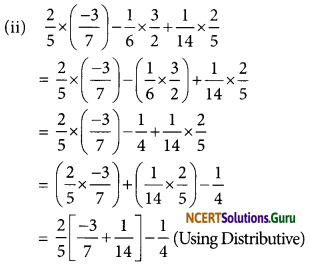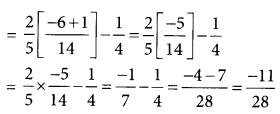NCERT Solutions for Class 7 Maths Chapter 13 Exponents and Powers Ex 13.2
These NCERT Solutions for Class 7 Maths Chapter 13 Exponents and Powers Ex 13.2 Questions and Answers are prepared by our highly skilled subject experts.
NCERT Solutions for Class 7 Maths Chapter 13 Exponents and Powers Exercise 13.2
![]()
Question 1.
Using laws of exponents, simplify and write the answer in exponential form:
(i) 32 × 34 × 38
(ii) 615 ÷ 610
(iii) a3 × a2
(iv) 7x × 72
(v) (52)3 ÷ 53
(vi) 25 × 55
(vii) a4 × b4
(viii) (34)3
(ix) (220 ÷ 215) × 23
(x) 8t ÷ 82
Answer:
(i) 32 × 34 × 38 = 32 + 4 + 8
(am × an × r = am+n+r) = 314
(ii) 615 ÷ 610 = \(\frac{6^{15}}{6^{10}}\) = 615-10
(\(\frac{a^{\mathrm{m}}}{\mathrm{a}^{\mathrm{n}}}\) = am-n) = 65
(iii) a3 × a2 = a3+2
(am × an = am+n ) = a5
(iv) 7x × 72 = 7x+2 (am × an = am+n )
(v) (52)3 ÷ 53

(vi) 25 × 55 = (2 × 5)5
[am × bm = (ab)m]
= (ab)4
(vii) a4 x b4
(viii) (34)3 = 312
[(am)n = amn]
(ix) (220 ÷ 215) x 23 = (\(\frac{2^{20}}{2^{15}}\)) x 23
= (220-15) × 23 [ \(\frac{a^{\mathrm{m}}}{\mathrm{a}^{\mathrm{n}}}\) = am-n]
= 25 × 23
= 25 + 3 (am x an = am+n) = 28
(x) 8t ÷ 82 = \(\frac{8^{t}}{8^{2}}=8^{t-2}\left(\frac{\mathrm{a}^{\mathrm{m}}}{\mathrm{a}^{\mathrm{n}}}=\mathrm{a}^{\mathrm{m}-\mathrm{n}}\right)\)
![]()
Question 2.
Simplify and express each of the following in exponential form:
(i) \(\)
(ii) [(52)3 × 54)] ÷ 57
(iii) 254 ÷ 53
(iv) \(\frac{3 \times 7^{2} \times 11^{8}}{21 \times 11^{3}}\)
(v) \(\frac{3^{7}}{3^{4} \times 3^{3}}\)
(vi) 2°+ 3°+ 4°
(vii) 2° × 3° × 4°
(viii) (3° + 2°) × 5°
(ix) \(\frac{2^{8} \times \mathrm{a}^{5}}{4^{3} \times \mathrm{a}^{3}}\)
(x) \(\left(\frac{a^{5}}{a^{3}}\right) \times a^{8}\)
(xi) \(\frac{4^{5} \times a^{8} b^{3}}{4^{5} \times a^{5} b^{2}}\)
(xii) (23 × 2)2
Answer:

= 2° × 33
= 1 × 33 = 33
(a° = 1)



(iv) \(\frac{3 \times 7^{2} \times 11^{8}}{21 \times 11^{3}}=\frac{3 \times 7^{2} \times 11^{8}}{3 \times 7 \times 11^{3}}\)
= 31-1 × 72-1 × 118-3
(\(\frac{\mathrm{a}^{\mathrm{m}}}{\mathrm{a}^{\mathrm{n}}}\) = am-n)
= 3° × 71 × 115
= 1 × 7 × 115
= 7 ×115

(vi) 2° + 3°+ 4° = 1 + 1 + 1 = 3 (a° = 1)
(vii) 2° x 3° × 4° = 1 × 1 × 1 = 3 (a° = 1)
(viii) (3° + 2°) × 5° = (1 + 1) × 1 = 3 (a° = 1)
= 2 × 1 = 2
![]()
(ix) \(\frac{2^{8} \times a^{5}}{4^{3} \times a^{3}}=\frac{2^{8} \times a^{5}}{\left(2^{2}\right)^{3} \times a^{3}}\)
= \(\frac{2^{8} \times a^{5}}{2^{6} \times a^{3}}\) [(am)n = amn]
= 28-6 × a 5-3 (\(\frac{\mathrm{a}^{\mathrm{m}}}{\mathrm{a}^{\mathrm{n}}}\) = am-n)
= 22 × a2
= 2a2
(x) \(\left(\frac{a^{5}}{a^{3}}\right)\) x a8 = (a5-3) x a8
[(am)n = amn]
= a2 × a8 (am x an = am+n)
= a2+8
= a10
(xi) \(\frac{4^{5} a^{8} b^{3}}{4^{5} a^{5} b^{2}}=\frac{4^{5-5} \times a^{8} \times b^{3}}{a^{5} \times b^{2}}\)
= 4° × a8-5 × b3-2 ( \(\frac{\mathrm{a}^{\mathrm{m}}}{\mathrm{a}^{\mathrm{n}}}\) = am-n)
= 1 × a3 × b
= a3b (a0 = 1)
(xii) (23 x 2)2 = (23+1)2
(am x an = am+n)
= (24)2
= 28 (am)n = amn
Question 3.
Say true or false and justify your answer:
(i) 10 × 1011 = 10011
(ii) 23 > 52
(iii) 23 × 32 = 65
(iv) 3° = (1000)°
Answer:
(i) 10 × 1011 = 10011
L.H.S = 10 x 1011
= 10(1+11)= 1012
(am × an = am+n)
R.H.S = 10011
= (102)H= 1022
(am)n = amn
L.H.S ≠ R.H.S.
∴ 10 × 1011 ≠ 10011
This statement is false.
![]()
(ii) 23 > 52
23 = 2 × 2 × 2 = 8
52 = 5 × 5 = 25
8 < 25
i. e. 23 > 52
This statement is false.
(iii) 23 × 32 = 65
L.H.S = 23 × 32
= 2 × 2 × 2 × 3 × 3 = 72
R.H.S = 65 = 6 × 6 × 6 × 6 × 6
= 36 × 36 × 6
= 7776
L.H.S ≠ R.H.S.
72 ≠ 7776
∴ 23 × 32 ≠ 65
This statement is false.
(iv) 3° = (1000)°
L.H.S = 3° = 1
R.H.S = (1000)°= 1
3° = (1000)°
L.H.S = R.H.S
3° = (1000)°
∴ This statement is true.
![]()
Question 4.
Express each of the following as a product of prime factors only in exponential form:
(i) 108 × 192
(ii) 270
(iii) 729 × 64
(iv) 768
Answer:
(i) 108 × 192
= 2 x 2 x 3 x 3 x 3 x 2 x 2

= 28 × 34
(ii) 270 = 2 × 3 × 3 × 3 × 5

= 2 × 33 × 5
(iii) 729 × 64
= 3 × 3 × 3 × 3 × 3 × 3 × 2 × 2 × 2 × 2 × 2 × 2

= 36 × 26
(iv) 768 = 2 × 2 × 2 × 2 × 2 × 2 × 2 × 2 × 3 = 28 × 3

Question 5.
Simplify:
(i) \(\frac{\left(2^{5}\right)^{2} \times 7^{3}}{8^{3} \times 7}\)
(ii) \(\frac{25 \times 5^{2} \times t^{8}}{10^{3} \times t^{4}}\)
(iii) \(\frac{3^{5} \times 10^{5} \times 25}{5^{7} \times 6^{5}}\)
Answer:
(i) \(\frac{\left(2^{5}\right)^{2} \times 7^{3}}{8^{3} \times 7}=\frac{2^{10} \times 7^{3}}{\left(2^{3}\right)^{3} \times 7}\)
[(am)n = amn ]
= \(\frac{2^{10} \times 7^{3}}{2^{9} \times 7}\)
= 210-9 × 73-1 [\(\frac{a^{m}}{a^{n}}\) = am-n]
= 21 × 72
= 2 × 49 = 98
Thus, \(\frac{\left(2^{5}\right)^{2} \times 7^{3}}{8^{3} \times 7}\) = 98
![]()



= 35-5 × 25-5 × 57-7
= 3° × 2° × 5°
= 1 × 1 × 1 = 1
NCERT Solutions for Class 7 Maths Chapter 13 Exponents and Powers Ex 13.2 Read More »





















